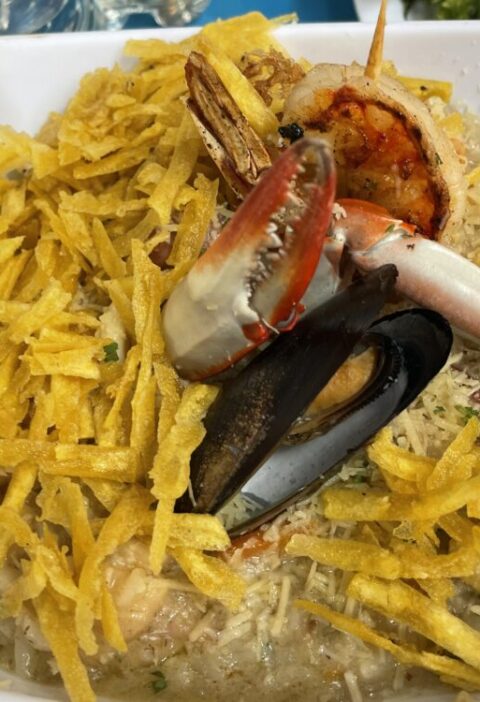Amazing we’ve been doing this project for ten straight weeks!!! That’s right. This episode is our ten week anniversary. Mostly, I’m amazed that Sam has not grown bored of this and is still willing to take time with me to prepare a complicated international dish.
He wishes we could make pizza for dinner every night, but I’m excited he’s tried things like couscous and Angolan chicken. This week, I imagine things will be easier for him to digest. Meat and potatoes.
It’s also the first country we’ve hit where I actually have some personal reference. Many years ago I had the absolute pleasure to spend some time in Austria. And I ate my weight in schnitzel, I assure you.
THE CUISINE

I am by no means an expert in Austrian food, but I fondly remember the incredible feast I was served at a wedding I had the opportunity to attend in the small little town of Blindemarkt. Funny enough, my biggest memory of the meal were the traditional chocolate Mozart Balls.
I also fondly remember eating in many beer halls through Vienna. Amazed I can remember as much as I do because beer was a big part of every meal – as is often the case in Vienna.
When people think of the major players in European food, they usually come up with France, Italy, Spain, and maybe Greece. But for some weird reason Austria gets overlooked. But the cuisine, especially that of Vienna, is sorely under-appreciated.
Vienna has its own style of cuisine called Viennese. It’s the only city in the world that has a cuisine named after it. There is no such term as New Yorkese cuisine. Although maybe there should be.
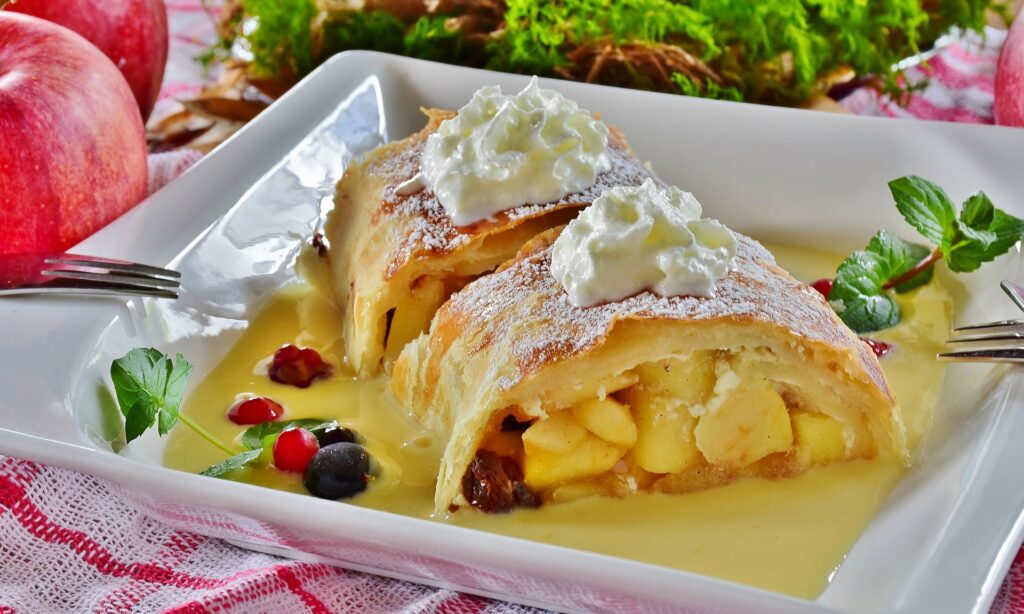
In Vienna, the most popular dishes are the Wiener schnitzel (which we tackle head on), along with a range of sausages, stews, and sweets including the famous Sachertorte (chocolate apricot cake) and Apfelstrudel (Apple strudel, anyone?).
Outside of Vienna, there is a continuation of hearty meats and carbs, but regional specialities abound. You might find lots of asparagus, or apricot dumplings, or sauerkraut noodles, or pig feet soup depending on where you are in the country.
Much of the country’s cuisine was influenced by the Austro-Hungarian empire, which of course Austria was a part of. Its food also takes nods from other current nations that had been part of the empire, including Poland, the Czech Republic, Hungary, and even regions of Italy.
And to wash it all down, Austria is widely known for both its beer, beautiful wines, and huge coffee culture (especially in Vienna). No wonder I liked it so much there.
AUSTRIAN FOOD IN NEW YORK
Most of the Austrian food in New York is actually found at fine dining establishments. There is a chef and restaurateur by the name of Kurt Gutenbrunner who over the years has had quite a few restaurants all specializing in Austrian cuisine.
His most famous is a highly rated place called Wallsé that I never had the pleasure (or money) to dine at.

I did happen to try his delicious pastries at Cafe Sabarsky, some expert schnitzel at the now closed Cafe Kristall, and spent a few nights (including one New Year’s Eve) at his more casual bistro Blaue Gans, which is also unfortunately now closed.
But by far, my favorite Austrian restaurant in the city is located in the historic German Lower East Side and it is about as comfortable and delicious as you can get. It’s called Café Katja and it was often a stop on our Tenements Tales and Tastes tour.
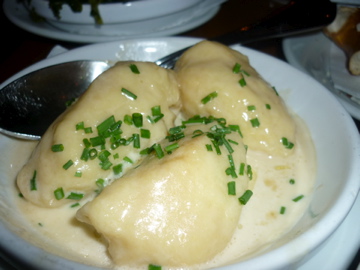
The chef Erwin even has his own You Tube channel that I recently discovered! Too bad I learned about it after I made a complete mess of the Wiener Schnitzel. If you want to try your hand at making your own, be sure to head down to Katja afterwards to see what it’s really supposed to taste like. Also, do not miss their dreamy quark dumplings.
THE VIDEO
In addition to food, Sam and I are learning a lot about language. I do my best at pronouncing dishes properly (hopefully I don’t butcher Erdäpfelsalat) and Sam finally comes to accept that words like “ketchup” are not the same in every country.
Mixing the potato salad was no match for Sam, but he did get a little beaten up by the shallots which made his poor little eyes burn.
As you will see, I had a very difficult time getting the schnitzels to look pretty. How do you say, “I’m still learning!” in German?
THE DISH

I wouldn’t be surprised if most Americans when asked, would pick Germany as the original home of the Wiener schnitzel. The Germans do indeed like their schnitzel, but it is not called Hamburger or Berliner Schnitzel. It’s called Wiener Schnitzel.
And, of course, Wiener refers to the city of Vienna (aka Wien).
Wiener Schnitzel is also supposed to be made with veal. I read there is an Austrian law that forbids any other meat from being called a Wiener schnitzel. Not sure how often that law is still upheld, but I didn’t want to get into any trouble, so I did my best to hunt down some veal cutlets.
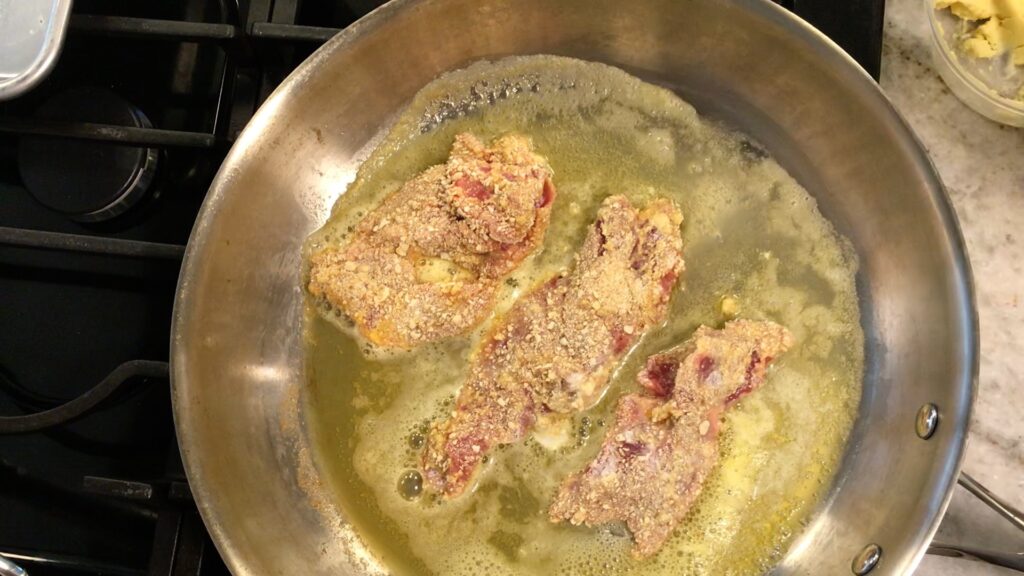
Whatever base you choose, it should be pounded thin and dredged in a mixture of eggs, flour, and breadcrumbs before being fried in clarified butter.
As a side dish, I had recently made a delicious potato salad recipe I found at Serious Eats. I thought it made sense to do an encore, although I made a few tweaks based on other research I discovered about how they do it in Austria.
Erdäpfelsalat translates to potato salad, of course. And instead of mayonnaise, which many Americans may be accustomed to, this potato salad is made with sunflower oil, white wine vinegar, mustard (the good stuff), and beef broth. And it’s often served warm or at room temperature. Although serving it cold would not hurt anyone.
THE RECIPE
For the erdäpfelsalat, I took many tips and ideas from the great website Serious Eats.
For the schnitzel, I adapted the recipe from the aptly named strudelandschnitzel.com
Wiener Schnitzel with Erdäpfelsalat from Austria

It really can not get more Austrian than Wiener Schnitzel. It comes from the city of Vienna (hence the name "Wien"er) and is traditionally always made with pounded veal. A side of tangy Austrian potato salad is the perfect accompaniment.
Wiener Schnitzel
- 4 veal cutlets (pounded very thin)
- 3/4 cup four
- 1 cup breadcrumbs
- 1/4 cup milk
- 1-2 tbspn clairified butter
Erdäpfelsalat (Austrian Potato Salad)
- 2 pounds waxy potatoes, like New, fingerlings, Red bliss, or Yukon Gold (peeled and cut into 1/2 inch slices, skins reserved)
- 3 tbspn white wine vinegar
- 1/4 cup sunflower oil (can sub olive oil)
- 1 tbspn Dijon mustard
- 3/4 cup red onion or shallot (minced)
- 2 tbspn fresh tarragon (chopped)
- 1/2 cup beef broth
- 2 tspn sugar
Erdäpfelsalat (Austrian Potato Salad)
-
Peel and slice potatoes into 1/2 inch slices. Season with salt.
-
Place potatoes in pot and cover with water. Put potato skins in a strainer on top and add enough water to submerge. Bring to boil and then simmer until potatoes are tender but not falling apart. About 12 minutes.
-
Discard skins and drain potatoes. Transfer to ri med baking sheet and immediately drizzle with 2 tbspns of white wine vinegar. Allow to cool.
-
When the potatoes are cool, transer to large bowl.
-
Add 1 more tbspn white wine vinegar, sunflower (or olive) oil, Dijon mustard, red onions (or shallots), tarragon, beef broth, and sugar.
-
Roughly stir with rubber spatula and fold mixture so potatoes release starch and liquid begins to thicken.
-
Season with more salt and white pepper. Set aside to rest and serve at room temperature or chilled.
Wiener Schnitzel
-
Ensure veal is pounded very thin. Season with salt and pepper.
-
Beat eggs with milk.
-
Place flour and breadcrumbs in their own flat plates.
-
Heat butter in pan in large skillet over medum heat.
-
One at a time, coat the meat with flour and brush off surplus. Dip meat in eggs and then coat generously in bread crumbs.
-
Once butter is adequately hot, place cutlets in pan to fry until they are golden brown. Ensure there is enough space between each cutlet in pan. Fry until both sides turn golden.
-
Remove and place on paper towels to drain.
HOW I SCREWED IT UP
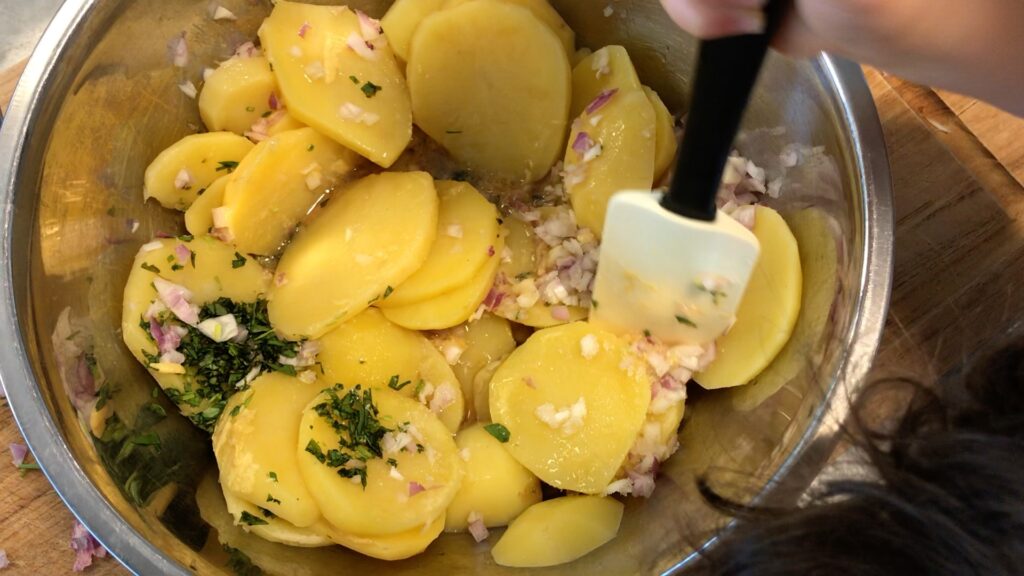
The potato salad came out perfectly. Of course, I had some practice having made a similar recipe a few weeks prior. Sam also helped with the mixing so it was pretty hard to screw up.
Now when it comes to the Wiener schnitzel, I can’t exactly pat myself on the back. Frying has never been my strong suit and I was trying not to drown the cutlets here as every recipe I encountered sayid to let it just swim in a shallow amount of butter.
I think the biggest problem was I bought pre-pounded cutlets and they were sliced comically thin. I think they may have been intended for wrapping around something rather than frying on their own. I had a very difficult time even keeping them together to dredge in the flour, eggs, and breadcrumbs.
So I put the blame on the butchering. But again, my frying skills didn’t help. I’m sure I didn’t wait for the butter to get hot enough and everything cooked unevenly. Some of the pieces burned while others didn’t seem to cook at all inside.
We managed to salvage a few pieces that were rather tasty and camera ready. But I have had many Wiener Schnitzels in my day and mine were not one of the better ones. And that’s ok.
But a better chef with properly pounded cutlets of veal could still use the recipe above and get a better outcome, I have no doubt.
SAM’S REACTION
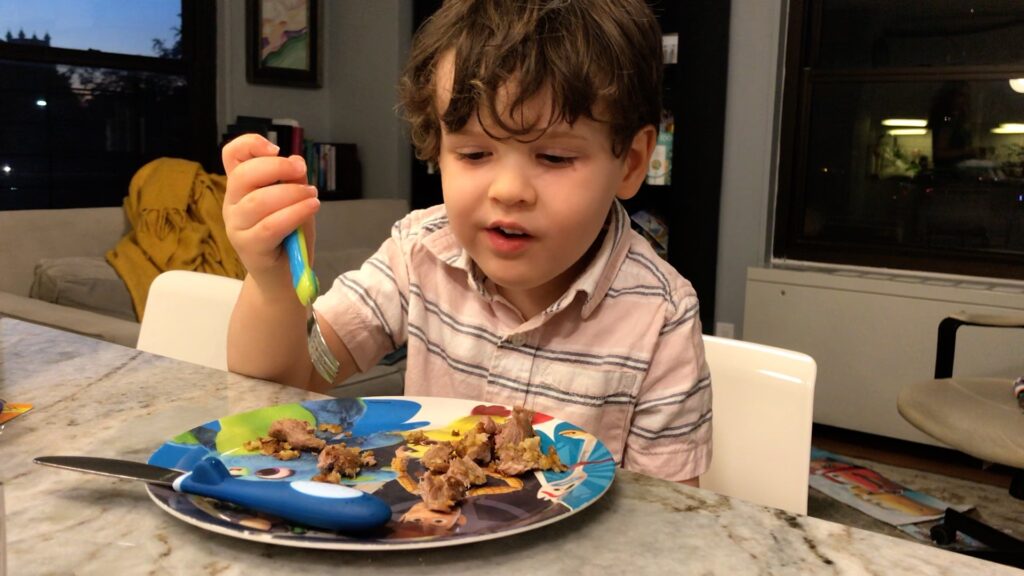
I made sure to give Sam some of the better pieces. He seemed really pleased with the meat. It was tender and tasty.
And while he was worried about the proper mixing of the potato salad, he would not actually taste the final product. He’ll eat potato chips and French fries, but any other preparation of potatoes is immediately shunned. So strange. Maybe it’s because he’s three??
NEXT WEEK

Next week we hit another milestone. We will have cooked the food of every country starting with the letter A.
I shouldn’t be as excited about this, but Sam is learning his alphabet and so checking off a letter is a big deal.
For the A finale, we’re heading back to the Caucasus Mountains for more delicious rice from the country of Azerbaijan.




